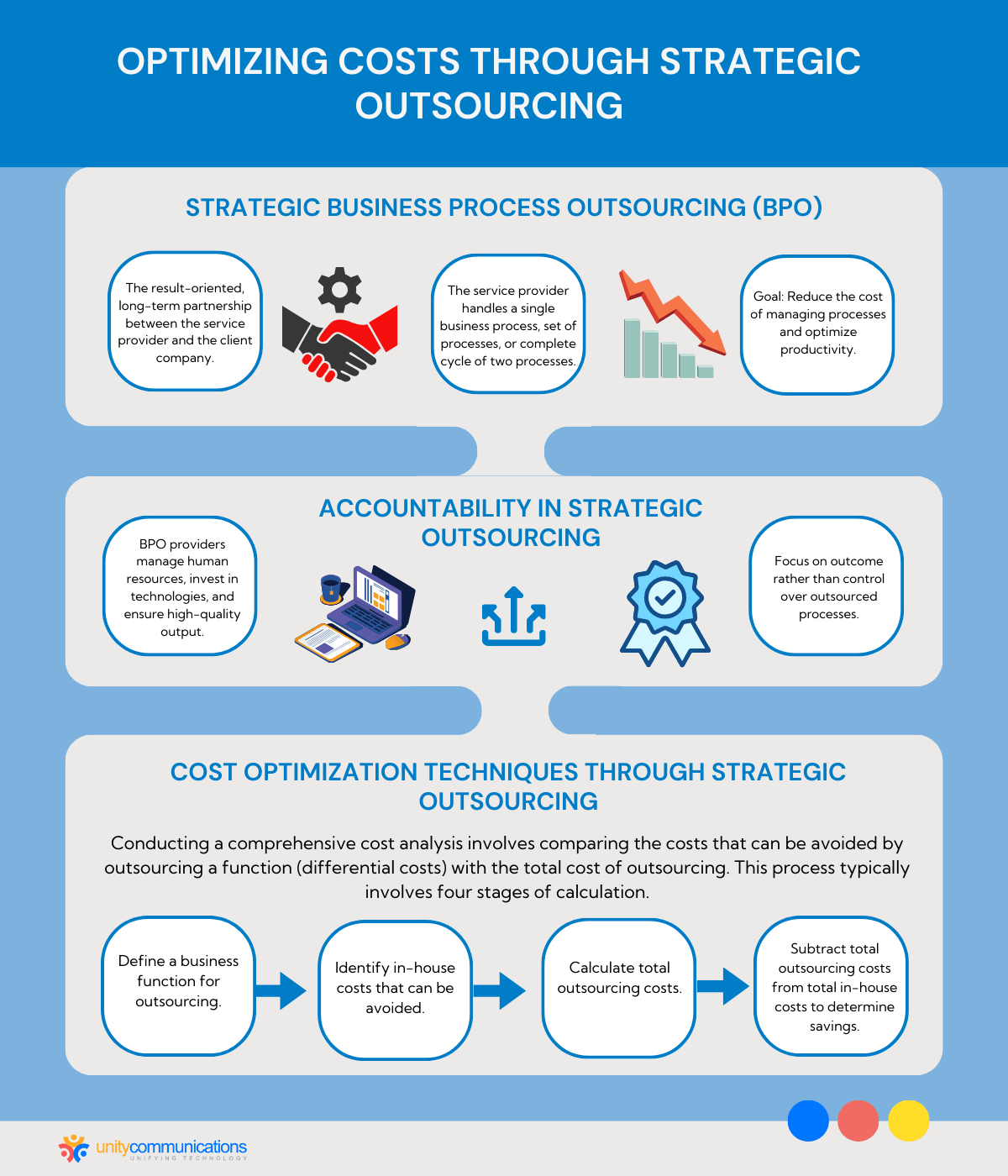Table of Contents
Full-time in-house teams do not always need to perform non-core business functions. You can subcontract specific processes to a BPO company in Phoenix and improve your overall productivity.
Moreover, the outsourcing industry continuously develops new approaches to help businesses at reasonable costs. Strategic outsourcing is a new method of delegating areas of operations to a third party.
In this article, we discuss cost optimization strategies through outsourcing in Arizona.
Strategies for Optimizing Costs Through Strategic Outsourcing
So what is strategic business process outsourcing (BPO)? Strategic outsourcing is a result-oriented, long-term business partnership between the service provider and the client company.
In this approach, the service provider may handle a single business process, a set of processes, or a complete cycle of two processes. The goal is to reduce the cost of managing the process and optimize productivity. Most of the time, the BPO arrangement is more important than maintaining control over outsourced processes or keeping non-core functions in-house.
Accountability is what separates strategic outsourcing from its legacy counterparts. The BPO providers are responsible for managing human resources (HR), investing in the needed technologies, and guaranteeing the production of high-quality output using the resources for which the client company has agreed.
Here are some cost optimization techniques through strategic outsourcing in Arizona:
Conducting a Comprehensive Cost Analysis
When a business function becomes too costly or distracts from your core competency, consider outsourcing it. You must weigh the risks and benefits of outsourcing when assessing the viability of turning over a process to a third party. You must also consider outsourcing’s return on investment and overall profitability.
One approach to performing a cost analysis is to measure the differential costs—the costs you can avoid by offloading the function—and compare them to the total cost of outsourcing. The four stages of this calculation are as follows:
Defining the business function, you plan to outsource
Finding the in-house costs that you could avoid by outsourcing
Calculating the total sum of outsourcing costs
Subtracting the total cost of outsourcing from the total in-house costs to get the savings
Here is a closer look at achieving cost optimization through a cost analysis of outsourcing in Arizona.
Step 1: Define the business function you plan to outsource
Defining the services you want to outsource and the workflow involved is vital. A clear understanding of the steps in the process helps you arrive at an accurate cost analysis. Last, ensure the solution the service providers propose meets your outcome expectations.
Having a business engineer for processes is also useful. The business engineer can help redesign the function to eliminate wasteful steps, thereby improving efficiency and lowering costs, even before considering outsourcing’s ability to achieve 70% cost savings.
Step 2: Find the in-house costs that you could avoid by outsourcing
Once you define the process, determine the cost your company can avoid by outsourcing. To do this, you can:
Itemize the direct costs (salaries, supplies, equipment, etc.) and indirect costs (internal services and general administration) involved in the process.
Do not list “sunk costs” or those you already incurred and cannot recover.
When deciding based on cost analysis, focus on avoidable future costs (costs that you can eliminate through outsourcing).
List all the internal costs you can avoid if you outsource the process.
This amount may differ from the total costs, especially if you retain a portion of the business process or maintain some control over the function.
Step 3: Calculate the total sum of outsourcing costs
Finding the total costs of outsourcing is the third step in cost optimization through outsourcing in Arizona. The back-office outsourcing provider’s bid price is the starting point but includes other expenses in administering the BPO engagement.
Step 4: Subtract the total cost of outsourcing from the total in-house costs to get the savings
Finally, calculate the potential cost savings that outsourcing may deliver. You can then justify outsourcing if the calculation shows you can massively minimize the business function’s costs. At this point, you can send a request for a proposal.
Negotiating Favorable Contracts and Pricing Structures
Technology and market developments have enabled client companies to significantly reduce costs by negotiating and renegotiating their outsourcing agreements. Here are different cost optimization opportunities through outsourcing in Arizona:
Lower supplier costs. You can lower average supplier cost per unit by minimizing requirements, aggregating volumes, and accepting generic solutions. For example, you can opt for call center agents that manage multiple clients instead of dedicated services. When suppliers’ costs are lower, they can reduce their charges while preserving profit.
Minimize risk premiums. Accepting more risk will reduce the risk premium. For example, you can allow currency fluctuation adjustments and other repricing options. You may also forego continuous improvement commitments and only pay for improvements when needed.
Agree to more collaboration. You can commit to offering resources to help the BPO firm perform instead of asking them to take full control. This leads to cost optimization if you can offer assistance for a fraction of the supplier’s cost. However, be careful to avoid paying the provider for work that you offer as collaborative help.
Permit transformative changes. BPO firms can offer tremendous cost savings if permitted to automate and standardize manual operations using tools such as contact center as a service (CCaaS), robotic process automation (RPA), and artificial intelligence (AI)-powered systems.
Pay in future years. You can minimize the first-year cost by agreeing to a longer partnership, spreading one-time expenses over the agreement’s life, or selling some assets to the provider for credits.
Offer non-cash compensation. Consider other ways to help your outsourcing provider. For example, you can allow them to use your name for marketing, offer them your data to train their machine learning tools, or use apps developed for you for other clients. You may also agree to be a reference customer for newly developed tools.
Limit unexpected changes. Invest your time and resources to craft a well-written BPO contract that guarantees a clear commitment to fulfilling your needs at acceptable compliance and performance levels and for a reasonable fixed price. Rushing to get your contract sorted without double-checking leads to waste.
Continuously improve the deal. You do not have all the information you may want or need the first time you negotiate the BPO contract. As you acquire more information, improve the agreement to maximize benefits.
More than half of companies that outsource do so to save on costs. Following these strategies can help, but you must invest time and resources and decide how to value relationships, risk, and service.
Implementing Effective Cost-control Measures
Cost optimization through outsourcing in Arizona means implementing cost-control measures by ensuring accountability and transparency, following effective vendor management practices, and utilizing technology to streamline processes. Check out the details below.
Ensuring accountability and transparency
Follow the steps below to maximize accountability and transparency when outsourcing a function and ensure a successful partnership:
Write clear contracts specifying quality expectations, deadlines, and task parameters. Ensure both parties understand and agree to their respective obligations and duties.
Establish key performance indicators (KPIs) and service-level agreements (SLAs) for outsourced work. This allows you to assess the service provider’s performance and check if it meets expectations.
Use a reliable reporting and monitoring system to keep track of the provider’s outsourced work.
Regularly review and revise the outsourcing contract to adapt to changing market conditions, expectations, and requirements.
Following effective vendor management practices
Strategic outsourcing calls for effective vendor management. Firstly, identify your outsourcing goals and the specific duties you will assign to the provider. Considering cost-effectiveness, flexibility, and expertise level, decide whether you will work with a single supplier or multiple specialized vendors.
Select the best service provider based on carefully evaluating their capabilities, experiences, and compatibility with your company, then draft substantial agreements. Include specific performance measures, incentives, and fines for non-compliance in the contract. This helps save costs since most expenses have been discussed and agreed upon from the beginning.
Utilizing technology to streamline processes
Technology is essential for streamlining outsourced processes and optimizing costs. Here are different ways you can use technology to improve BPO costs and processes:
Cloud solutions: Cloud computing and file sharing revolutionized how clients transferred data to BPO partners. You can use these features for real-time updates and seamless file sharing, enabling multiple users to access and work on the same file.
Collaboration tools: Effective communication is essential for outsourcing, so consider using messaging tools such as instant messaging or video conferencing and collaboration platforms such as Slack, Asana, and Trello.
Project management software: Project management tools allow clients to assign tasks, manage projects, monitor progress, and allocate resources to the third-party team.
The Bottom Line
Clients with far-ranging plans should consider strategic outsourcing to remain competitive. With proper planning, accurate cost analysis, effective vendor management, and favorable contract negotiations, client companies can optimize costs and reap many benefits.
Part of strategic outsourcing is taking risks into account. However, choosing a reputable BPO partner like Unity Communications can help avoid risks.
Ready to begin outsourcing? Contact us, and let’s connect!





